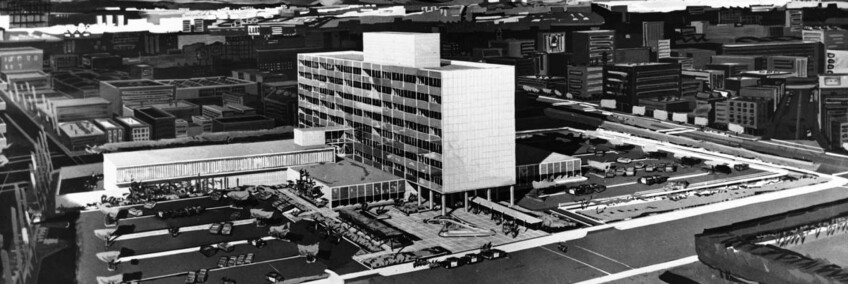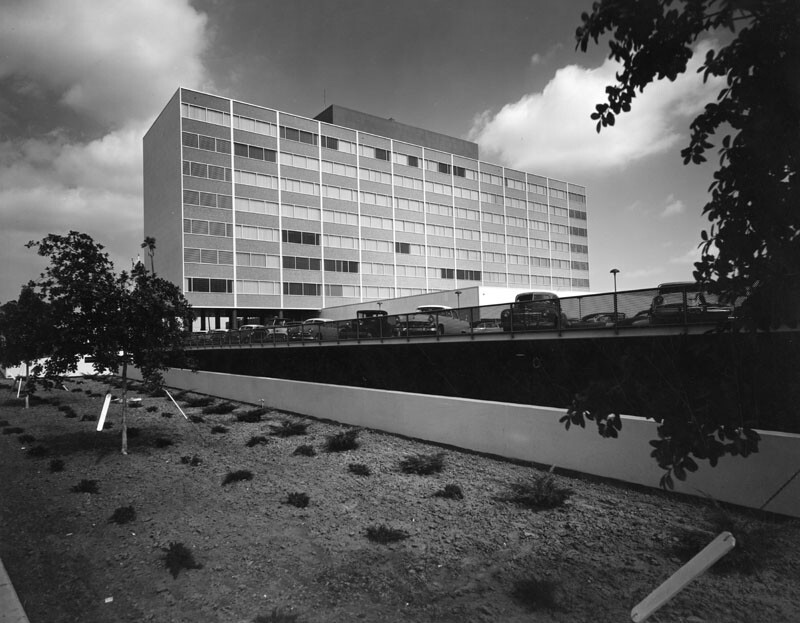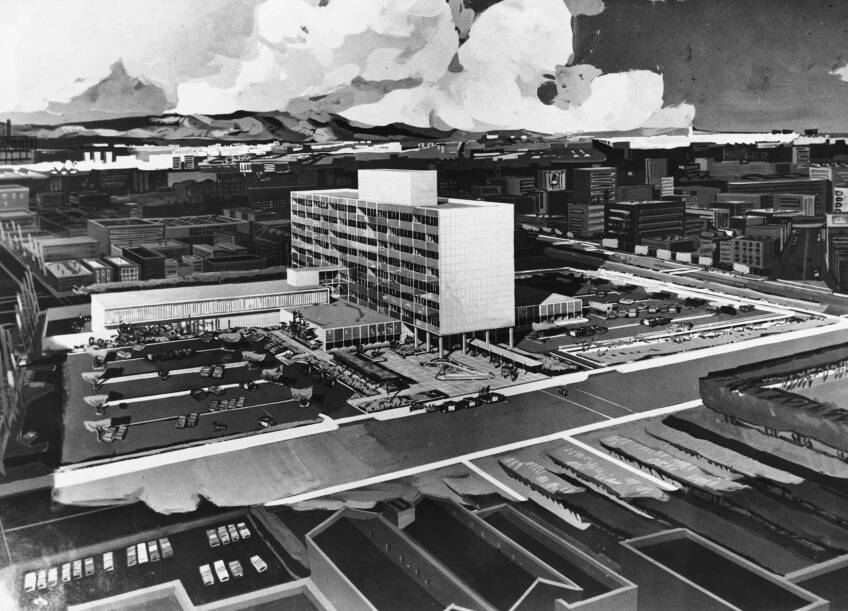Parker Center: Preserve? Repurpose? Demolish?

Parker Center – the former Los Angeles Police Department (LAPD) headquarters downtown – waits like some criminal suspect for the jury’s verdict. In this case, the jury is still out, since the city council’s Entertainment and Facilities Committee failed on Tuesday to arrive at a consensus about the building’s fate.
Councilman Mitch O’Farrell, the committee’s chair, put off decision-making until the Planning and Land Use Committee has acted on a Cultural Heritage Commission recommendation that Parker Center be given historic status. The wait may extend into mid-February.
Gail Kennard, vice president of the commission and an architect herself, admits that the Mad Men-era structure is not an easy building to love, but she would preserve it. The reasons are many.
Parker Center is a remnant of the modernist aesthetic that swept American architecture in the post-World War II period.
Parker Center is a remnant of the modernist aesthetic that swept American architecture in the post-World War II period. Its architects – Jesse Stanton and Welton Becket – designed other landmarks of mid-century Los Angeles. Its landscape architect – Ralph E. Cornell – was Southern California’s most influential. The building is historically significant just as a police headquarters that, upon its dedication in 1955, integrated new technologies and modern forensic science into police work for the first time.

Parker Center even is a Hollywood star of a sort. Its slab-sided exterior was made famous on the TV series “Dragnet,” and in other TV shows and motion pictures.
A history of racial antagonism is part of Parker Center’s legacy.
Famous, but also notorious. A history of racial antagonism is part of Parker Center’s legacy. In the 1970s, protests against the LAPD’s discriminatory hiring practices filled the street in front of the building. In the 1980s, African-American and Latino community members demonstrated there against harsh police tactics. When the city erupted after the Rodney King verdicts in 1992, Parker Center was the place where thousands of angry residents gathered to demand justice from a police force they considered to be brutal and uncaring.
Kennard believes that Parker Center’s “negative history” needs as much preserving as the nostalgic history that led to the preservation of city hall and central library buildings. Others are less sure.


Yukio Kawaratani, a retired urban planner and a member of the Little Tokyo Historical Society, told the city council committee that Parker Center remains a wound in the fabric of the Japanese community. In 1953, construction of the building and its parking lots demolished one-fourth of Little Tokyo’s business district along with the homes of nearly 1,000 residents. “It was an immense environmental impact on the community. We want to forget it,” he said. “Don’t continue to memorialize a bad building and police chief.”
In the most recent master plan for downtown development, Parker Center is already demolished, an assumption that supporters of the building’s preservation reject as premature.
The alternative, preferred by the city’s Bureau of Engineering, is demolition and a new office tower that would supply much of the 1.1 million square feet of space the city desires. In the most recent master plan for downtown development, Parker Center is already demolished, an assumption that supporters of the building’s preservation reject as premature. The Los Angeles Conservancy and others believe that adaptive reuse of the existing building and the construction of a new building around Parker Center would deliver the office space the city says it needs as well as retain the civic center’s historical continuity.
Preservationists also reject the calculations that make adaptive reuse costlier than demolition and replacement. According to city engineers, reusing Parker Center and constructing a new building around it would cost $621 million, versus $514 million to tear it down and put up a new building. But those costs haven’t been subjected to much review or any analysis by a neutral evaluator.


The messy politics of downtown redevelopment is part of the Parker Center equation, too. Little Tokyo civic leaders had been in favor of preservation. Now they’re opposed, perhaps because the civic center master plan (without Parker Center) includes more than a thousand new parking spaces adjacent to Little Tokyo businesses.
Parker Center has become a political football and test of the city’s commitments to its own history. In 2013, when the building faced demolition, the Cultural Heritage Commission submitted an application to grant the building historic status. The application was on the commission members’ own referral, something rarely done. But the city council’s Planning and Land Use Management Committee, responsible for the next step in confirming that first nomination, let a procedural deadline pass – by design or inadvertence – without action. In September 2016, the Cultural Heritage Commission submitted a new application to the Planning and Land Use Management Committee. That application has yet to be considered. In November, the Cultural Heritage Commission unanimously voted to declare Parker Center a “City Historic-Cultural Monument.” In December, the Bureau of Engineering once again recommended razing the building.
Because remembering is learning, it’s important to the future of the city that we preserve sites that contain our memories, especially those we might want to forget.
Today, Parker Center remains empty, as it has been since 2009 when the new LAPD headquarters opened nearby. Its ambiguous status remains half embraced as historic and half convicted of uselessness.
In 2015, writing about the problem of remembrance that Parker Center represents, I argued that the least understood power of government – and yet one of its most potent – is its power to preserve a memory. Parker Center’s empty corridors and offices are filled with memories, many of them painful. But because remembering is learning, it’s important to the future of the city that we preserve sites that contain our memories, especially those we might want to forget.
The question for the Los Angeles City Council is how much willful forgetting will it abet?
